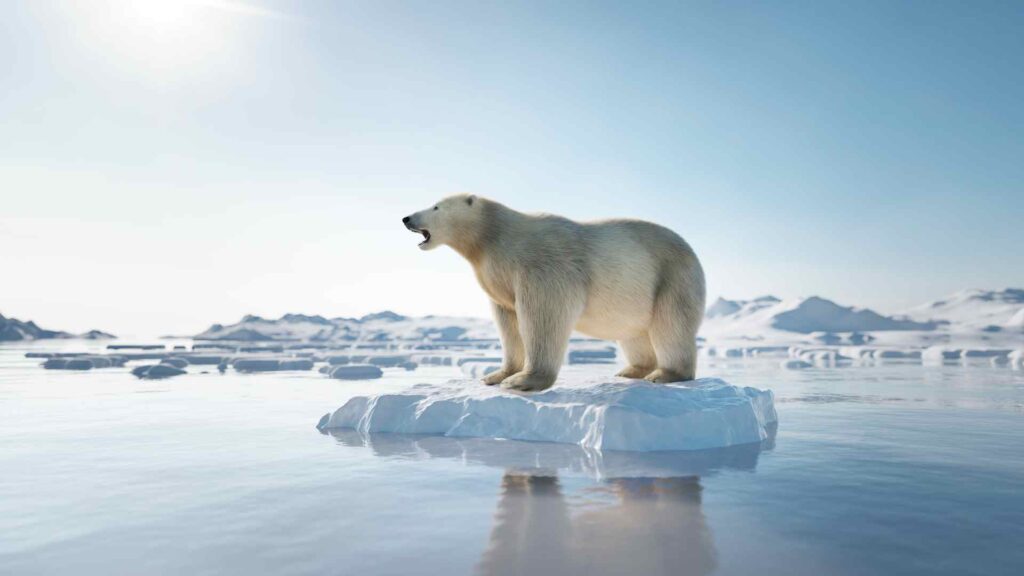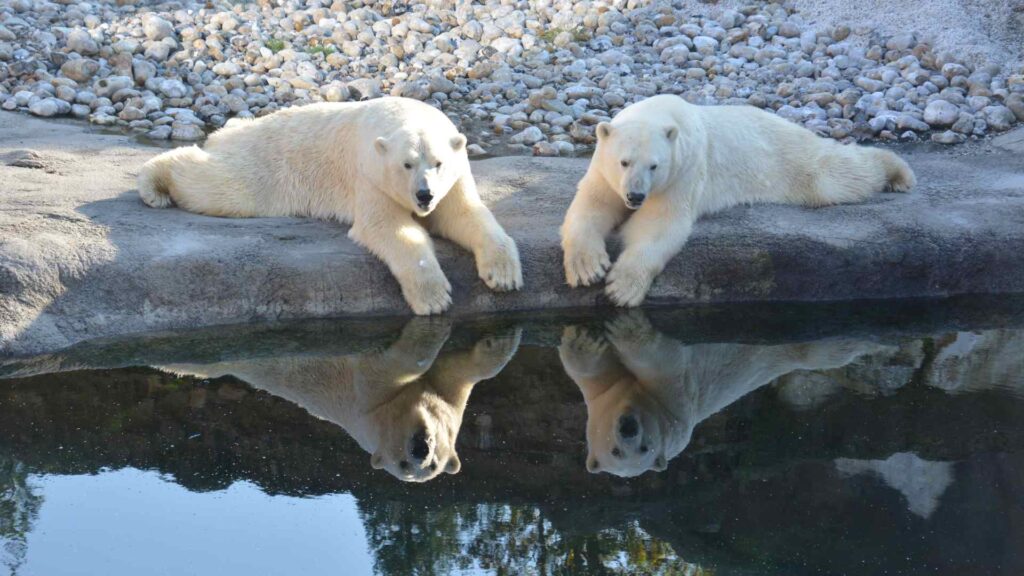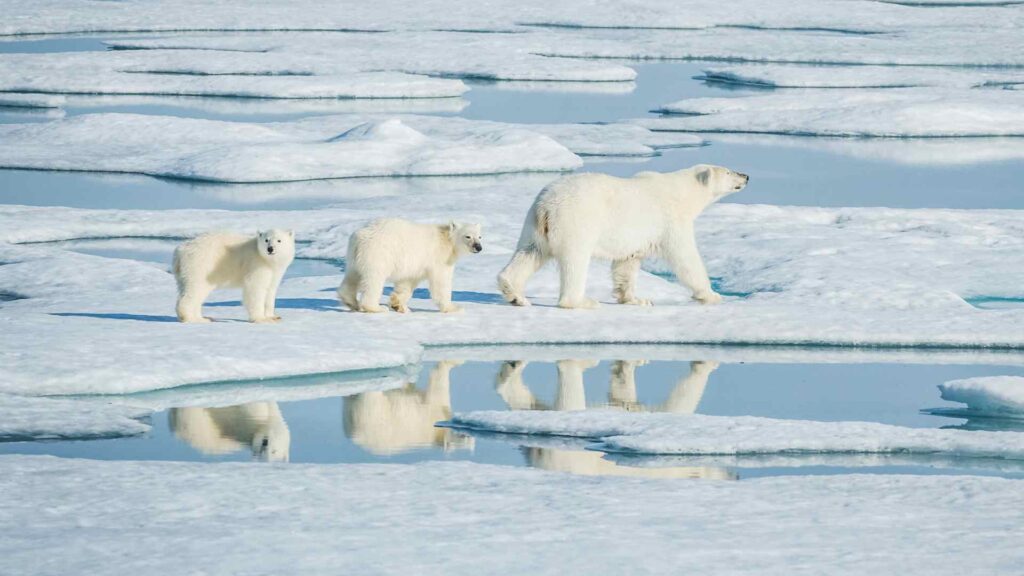Polar bears are among the most majestic and mysterious creatures on Earth.
From their icy habitats to their unique adaptations, they captivate our imagination.
In this ultimate guide, you’ll explore 145 incredible facts about polar bears, categorized for easy reading, plus a bonus section loaded with fun trivia!
Polar Bear Anatomy and Physical Adaptations
- Polar bears have black skin underneath their white fur to absorb and retain heat.
- Despite their white appearance, polar bear fur is actually transparent.
- A polar bear’s paw can measure up to 12 inches across, perfect for walking on ice.
- Their thick blubber layer can be up to 4.5 inches thick, insulating them against freezing temperatures.
- Polar bears have an excellent sense of smell, capable of detecting seals nearly a mile away.
- Their fur is oily and water-repellent, allowing them to shake off water after a swim.
- A polar bear’s tongue is bluish-black in color, adding to their unique appearance.
- Their claws are short and thick, designed for gripping ice and catching prey.
- Polar bears have 42 teeth, including sharp canines for tearing meat.
- The pads of their paws are covered in small, soft bumps to prevent slipping on ice.
- Polar bear noses are highly sensitive, helping them locate breathing holes in ice.
- They can swim at a speed of 6 mph and cover distances of over 60 miles.
- Their eyes have a special layer that enhances night vision for hunting in dim light.
- A polar bear’s head is smaller relative to its body, an adaptation for streamlined swimming.
- They rely on their massive size to maintain body heat in the Arctic environment.

Hunting and Diet
- Polar bears are carnivores, with seals making up most of their diet.
- They use a technique called still-hunting to catch seals, waiting patiently by breathing holes.
- During a successful hunt, a polar bear can consume up to 100 pounds of blubber.
- Polar bears rely on sea ice to access their prey; they’re at risk when ice melts.
- They are known to eat the entire seal, leaving almost no waste.
- Polar bears will scavenge carcasses of whales or walruses when seals are scarce.
- They sometimes consume kelp as a supplement, especially in lean months.
- Polar bears can go without food for several months during summer when ice is scarce.
- They’re known to hunt beluga whales or narwhals trapped in ice pockets.
- When hunting, they use their white fur as camouflage against the snow and ice.
- They are solitary hunters, rarely sharing food with others.
- Polar bears have been observed eating birds, eggs, and small rodents in extreme situations.
- Cubs learn hunting skills by watching their mothers.
- Starvation is one of the main threats polar bears face due to habitat loss.
- Polar bears are apex predators, sitting at the top of the Arctic food chain.
Habitat and Range
- Polar bears live in the Arctic Circle, including Canada, Alaska, Russia, Greenland, and Norway.
- They are closely tied to sea ice, which they use as a platform for hunting.
- Polar bears can traverse up to 1,000 miles in search of food or mates.
- Their territory overlaps with that of other Arctic animals, including Arctic foxes and seals.
- Polar bears are excellent swimmers, known to cross stretches of open ocean.
- They favor areas with dense ice floes, where prey is most abundant.
- Polar bears sometimes den on land during the summer months.
- They dig snow dens to shelter from harsh Arctic winds.
- Their range is shrinking due to climate change and melting ice.
- The southernmost populations of polar bears live in James Bay, Canada.
- Pregnant females create dens in snowdrifts to give birth and care for their cubs.
- They are highly adaptable and can survive in a variety of Arctic conditions.
- Polar bears rely on permafrost and snowbanks for denning purposes.
- They sometimes migrate with the seasonal movement of ice.
- Their habitat is among the most extreme environments on Earth.

Reproduction and Cubs
- Polar bears typically give birth to twins, though single or triplet births can occur.
- Cubs are born in the winter, usually between November and January.
- At birth, polar bear cubs weigh less than two pounds and are blind and toothless.
- Mothers nurse their cubs for up to 30 months, providing nutrient-rich milk.
- Cubs grow rapidly, doubling in size within their first few weeks.
- Female polar bears are fiercely protective of their cubs, often fending off male bears.
- Mating occurs on the ice, with males sometimes fighting for access to females.
- Female polar bears gain significant weight before pregnancy to sustain themselves and their cubs.
- Cubs begin exploring outside the den at around three months old.
- Mothers teach cubs essential survival skills like hunting and swimming.
- Cubs remain with their mothers until they’re about two and a half years old.
- Polar bear dens are typically located in snowbanks or thick ice.
- Polar bears only reproduce every three years, making population recovery slow.
- Male polar bears do not participate in raising cubs.
- Survival rates for cubs are low, especially with changing climate conditions.

Bonus Facts About Polar Bears
- Polar bears are considered marine mammals because they spend so much time on ice and in water.
- They can overheat if they run too fast due to their insulating layers.
- The scientific name for polar bears, Ursus maritimus, means “sea bear.”
- Their thick fur appears fluorescent under UV light.
- Indigenous Arctic peoples often revere polar bears in their folklore.
- Polar bears are classified as vulnerable on the IUCN Red List.
- They rely on their blubber for buoyancy while swimming.
- Some polar bears can live up to 25 years in the wild.
- Polar bears sometimes eat snow to hydrate themselves.
- Their powerful limbs allow them to climb steep ice ridges.
- Male polar bears can weigh up to 1,500 pounds, making them the largest land carnivores.
- Polar bears have been observed sliding on ice for fun.
- They rely on the fat of their prey to provide energy during fasting periods.
- Polar bears have non-retractable claws, perfect for gripping ice.
- In captivity, polar bears have lived as long as 43 years.
- Polar bears are not afraid of humans, which can make encounters dangerous.
- Their sharp sense of hearing allows them to detect distant noises.
- Melting sea ice directly impacts their ability to find food.
- Polar bears play a critical role in maintaining Arctic ecosystems.
- A group of polar bears is called a “celebration” or “aurora.”
- Polar bears can detect a seal under three feet of snow with their keen sense of smell.
- They are excellent divers and can dive as deep as 15 feet when chasing prey.
- A polar bear’s heart rate can slow down during dives to conserve oxygen.
- Unlike most bears, polar bears do not hibernate, except pregnant females.
- Polar bears have a layer of fur even on the soles of their feet for warmth.
- The hairs on their fur are hollow, which aids in insulation and buoyancy.
- They are solitary animals, coming together only during mating season.
- Polar bears can consume up to 20% of their body weight in one meal.
- Their fur can yellow with age or exposure to the sun.
- Polar bears communicate using body language, such as nose-to-nose greetings.
- They use their sharp sense of smell to locate prey up to 10 miles away.
- Polar bears are considered keystone species, vital for the Arctic ecosystem.
- They rely on fasting for long periods when food is unavailable.
- Males can grow up to 10 feet tall when standing on their hind legs.
- Polar bears have three eyelids; the third protects their eyes from snow glare.
- During long swims, polar bears rely on their fat reserves for energy.
- Polar bears can suffer from climate-induced stress, affecting their behavior.
- The Inuit name for polar bears is “Nanook,” meaning “master of the ice.”
- They have been observed using tools, such as ice blocks, to hunt prey.
- Polar bear milk is among the richest in the mammal kingdom, packed with fat and protein.
- Their liver contains high levels of vitamin A, which is toxic to humans in large amounts.
- Polar bears have unique individual nose patterns, much like human fingerprints.
- They are capable of outrunning a human over short distances.
- Cubs are playful, often engaging in mock fights to build strength and skills.
- Polar bears use ice as platforms for resting during long swims.
- Some polar bears walk over 30 miles a day in search of food.
- Polar bears are capable of fasting for months, especially in summer.
- Their thick blubber layer can account for up to half their body weight.
- Polar bears can give birth in the same den used by their mothers.
- They can eat up to 60% of their annual calorie intake in late spring and early summer.
- Polar bears are surprisingly agile on land despite their size.
- When swimming, they use their front paws for propulsion and hind legs for steering.
- They shed their fur annually in a process called molting.
- Polar bears can get frostbite on their noses and feet during extreme cold.
- Their bites are among the most powerful in the animal kingdom.
- The oldest polar bear in captivity lived to be 42 years old.
- Polar bears are classified as hypercarnivores, relying almost entirely on meat.
- They mark their territory by rubbing their scent onto the ice.
- Polar bears are ambush predators, often waiting hours for the perfect moment.
- They have a reflective layer behind their retinas, which improves night vision.
- Polar bears’ scientific classification places them close to brown bears.
- Cubs practice pouncing by leaping onto snow mounds or small prey.
- They don’t drink water; their hydration comes from the prey they eat.
- The fat from seals provides not just calories but also hydration.
- Their biggest threats are climate change, habitat loss, and pollution.
- Polar bears are often used as symbols of Arctic conservation efforts.
- They sometimes swim between ice floes to cool off during hunts.
- Polar bears’ hunting success rate is low; they catch a seal in only about 2% of attempts.
- Researchers study polar bears to learn about the effects of global warming.
- Despite their fearsome reputation, polar bears are vulnerable and need our protection.
Conclusion:
Polar bears are truly fascinating creatures with remarkable adaptations to thrive in the harsh Arctic environment. Learning about them not only deepens our appreciation for nature but also underscores the importance of protecting their fragile habitat.
